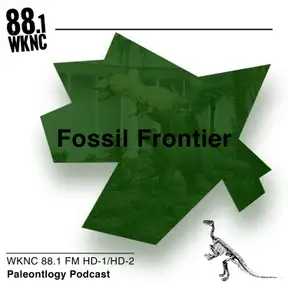Coelacanth: The Fish That Came Back From The Dead
Download MP3Scrimble 0:05
Hello everybody. I'm scrimble and welcome to the seventh episode of my podcast, fossil frontier, a paleontology podcast brought to you by wknc 88.1 this show will be dedicated to talking about my favorite fossils and prehistoric phenomena, we're going to explore some of Earth's ancient treasures and uncover the stories that they have to tell. So if that's something you're into, you better lock in, because this week we're talking about the coelacanth, the living fossil that came back from the dead. Okay, So picture this. It's 1938 and Marjorie Courtney Latimer, a museum curator, is on the coast of South Africa when she discovers a strange looking fish among the catch of a local fisherman. The fish was unlike any other specimen found in the sea. It's about five feet long, dark blue with light spots, and has a unique almost limb like fin pattern. Intrigued by this discovery, Courtney Latimer had it taxidermied and took it to scientist, JLB Smith, who, after much studying of its lobed fins in plump body, identified it as the coelacanth. Case closed, right? Not exactly because before this discovery, the coelacanth was thought to have been extinct for almost 66 million years. So the question is, why did the species come back from the dead, almost untouched by evolution after these millions of years? And what can the coelacanth tell us about life today? Well, because paleontologists weren't able to find any living specimens and could only procure fossils from over 66 million years ago, they assumed that the coelacanth was wiped out in the Cretaceous Tertiary, or KT extinction event that killed the dinosaurs. So they were dubbed a Lazarus species, named after the biblical Lazarus, meaning they came back from the dead. That being said, if you asked any local fishermen about the specimen, they would explain that they've been catching them for years. And really, the discovery of the coelacanth was only new to the scientific community. But that's neither here nor there. The reason why these guys were so hard to find is because they mostly dwell in deep underwater caves where they passively drift feed on smaller fish and cephalopods. They were able to evade researchers for years, but new technology has allowed us to see them up close and study their behavior and characteristics, and what we found has only solidified their nickname as the living fossil. You see in terms of osteichthys or bony fish, there are really only two types. There's the ray finned fish. These are most of the fish that we know and love. Their fins are made of skin and webbing. And then there's the lobe finned fish. These guys have fins that are very similar to our limbs, with pseudo arm and finger bones. There's only two living species of lobe finned fish today, the lungfish and the coelacanth, but this clade is one of the most important steps in the evolutionary history of humans, as well as every other tetrapod today. This is because the lobe finned fish were the precursors to tetrapods their limb, like fins, would eventually evolve into actual limbs used by the Tiktaalik to make its way onto land for the first time. Once there, the tetrapods would take over forming almost all the land animals that we see today, from birds to frogs to dogs and cats and even humans. So the coelacanth is basically the living form of the transition between water and land. In fact, it's actually more related to us than it is to other fish. Ultimately, as a living fossil, the coelacanth offers invaluable insights into evolutionary biology bridging the gap between fish and tetrapods, it has been virtually untouched by evolution for millions of years, looking exactly like it would have when dinosaurs roamed the earth. And just think it was thought to be extinct until very recently. It makes you wonder what else could be lurking down there in the ocean just waiting to be discovered. But the coelacanth story is a testament to the importance of exploration and the possibility that other extinct species may still survive hidden away in the unexplored corners of our planet. It serves as a reminder of how much there's yet to learn about Earth's biodiversity and the enduring legacy of its ancient inhabitants. Thank you for listening to the seventh episode of fossil frontier. This has been a wknc podcast. Good night, and I love you. The audio used in this podcast was Song Thrush, nature field recording, garden atmo recorded by Garuda 1982 under Creative Commons license.
Transcribed by https://otter.ai

